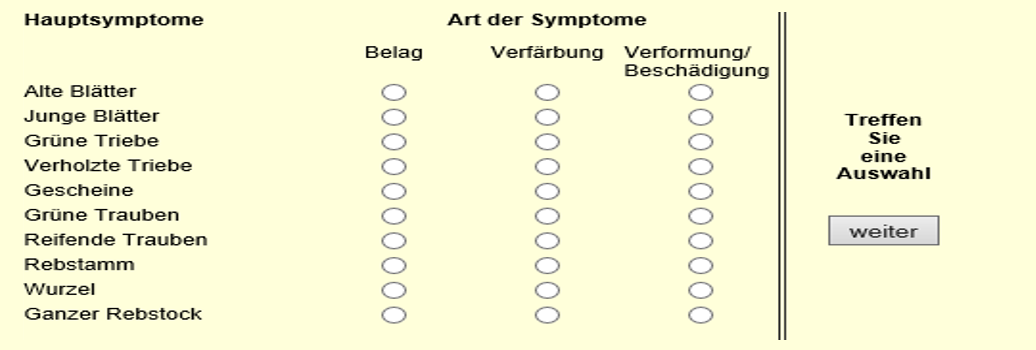For a complete list regarding all harmful influences in viticulture (harmful organisms, pollutants, animals, diseases, weather and environment) see Vine Enemies.
Vine enemies
The numerous enemies of the grapevine can be divided into the groups of microorganisms such as bacteria, fungi and viruses, as well as animal pests, which act indirectly by transmitting diseases or directly through, for example, root feeding or consequential damage such as rot. Some diseases are also caused by a lack of nutrients. Many diseases are of European origin, some were "imported" from North America from the middle of the 19th century. These were, in order, phylloxera, powdery mildew (Oidium), downy mildew (Peronospora) and black rot (which were referred to as the "four great plagues"), as well as flavescence dorée (golden yellowing) in the 1940s.

Control
It would be fatal to combat these diseases and pests only when they occur. For this reason, preventative measures are generally used today. These include the selection of grape varieties (fungus-resistant PIWI varieties), biotechnical measures such as grafting, appropriate vineyard care, mechanical methods (protective screens against birds), the use of chemical agents (pesticides) and, increasingly, ecological methods such as beneficial insects or confusion methods. Environmentally friendly plant protection measures are part of organic (ecological) viticulture in various forms.
Resistance
In the course of many millions of years of evolutionary history, grape varieties have developed resistance (resilience) to their enemies, such as phylloxera and mildew, as well as to extreme environmental conditions such as drought or frost. These characteristics are especially taken into account when breeding new grape varieties. Animal pests, especially insects with their eggs and larvae, are also eliminated by their natural enemies or antagonists, i.e. by other insects or microorganisms. Today, this is consciously utilised in pest control, for example by deliberately releasing ladybirds or introducing nematodes into the soil.
Test methods
In recent decades, a number of test methods have been developed to identify vine diseases, even in quarantine in the case of imports. These are ELISA, indexing and PCR (polymerase chain reaction). Some (latent) diseases can also be spread by infected plant material during grafting, for example the wood disease group Rugose Wood-Complex. A project was launched in Austria in 1993 with the aim of improving quality in the long term by carrying out appropriate analyses and selecting the healthiest possible vine material (certified clones).
The virtual vine doctor
The State Teaching and Research Centre for Viticulture and Fruit Growing in Weinsberg operates the website "Der virtuelle Rebendoktor" (The virtual vine doctor). The symptoms are queried on the homepage, which makes it possible to narrow down the symptoms. The database contains the symptoms of the most common diseases, pests, vine deficiencies and other impairments to vine growth. Together with explanatory texts, the vine doctor provides assistance in clarifying the causes of disease and damage. Links on the website lead to further information and tips on how to remedy the damage that has occurred and how to avoid the causes of disease and damage.

Diseases and pests
All diseases and pests are described with cause, symptom, effect and control as well as their occurrence. However, there are also micro-organisms and insects that act as beneficial organisms in the vineyard and are deliberately encouraged. The individual keywords are summarised in five groups according to their causes:
- Bacterial and viral diseases
- Fungal diseases
- Animal pests
- Nutrient deficiency/surplus & supply of the vine
- Environment
Bacterial and viral diseases

- Bacterial necrosis
- Leaf roll disease
- Vinegar rot
- Fasciation (vein banding, banding, zigzag growth)
- Flavescence dorée (golden yellow yellowing)
- Kerner disease (belongs to...
Voices of our members

As honorary chairman of the Domäne Wachau, it is the easiest and quickest way for me to access the wein.plus encyclopaedia when I have questions. The certainty of receiving well-founded and up-to-date information here makes it an indispensable guide.
Hans-Georg Schwarz
Ehrenobmann der Domäne Wachau (Wachau)